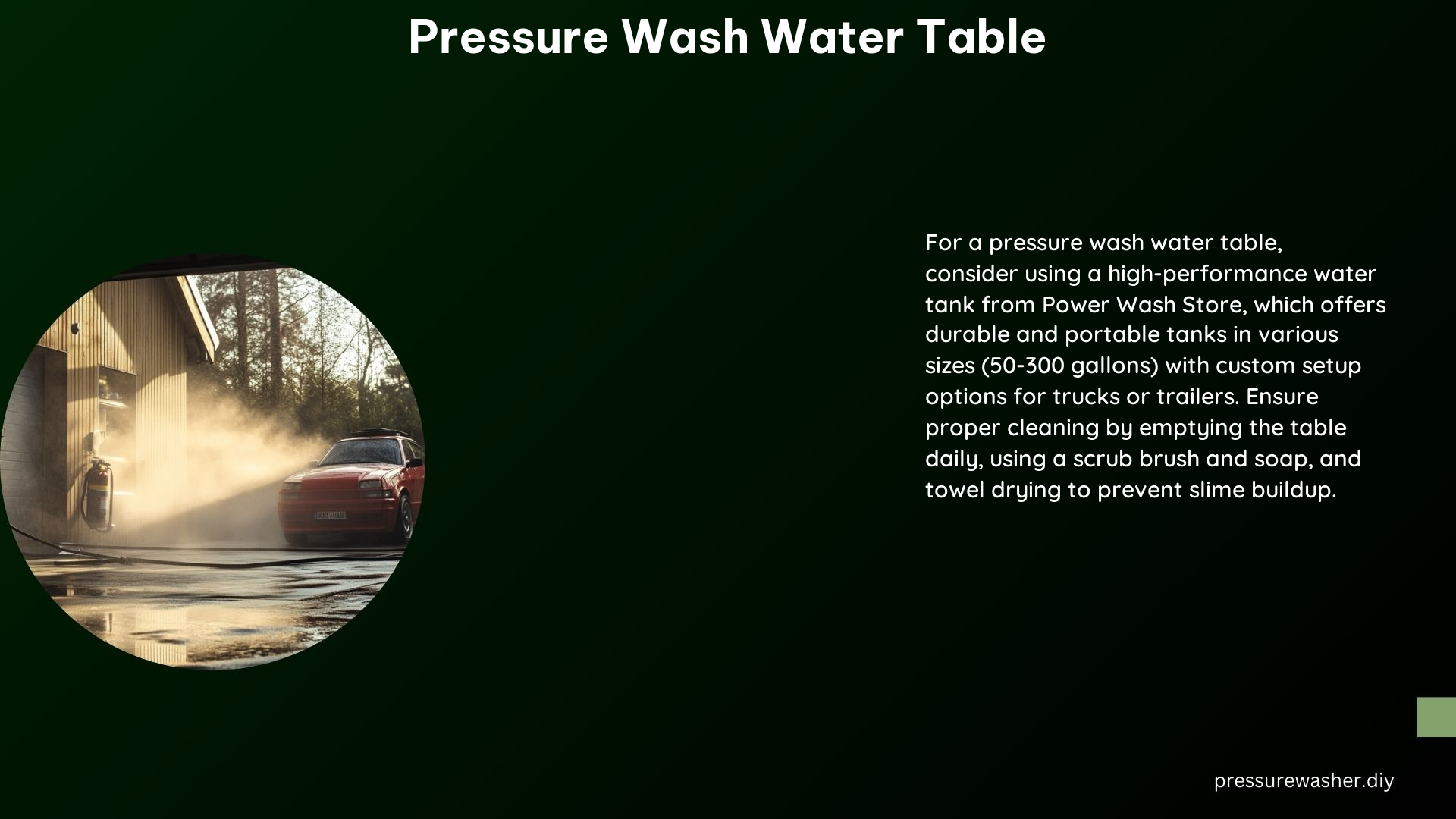Pressure washing a water table can be an effective way to keep it clean and well-maintained, but it’s important to use the right techniques and equipment to avoid damage. This comprehensive guide will provide you with all the necessary information to pressure wash your water table efficiently and safely.
Choosing the Ideal Pressure Washer for a Water Table
When it comes to pressure washing a water table, the key is to use a pressure washer with the right specifications. The ideal pressure washer for a water table should have the following characteristics:
- PSI (Pounds per Square Inch): For a water table, you’ll want a pressure washer with a relatively low PSI, typically between 1,000 to 1,500 PSI. This lower pressure will help prevent damage to the delicate surfaces of the water table.
- GPM (Gallons per Minute): The GPM of the pressure washer should also be on the lower side, around 1.5 to 2.5 GPM. This will ensure that the water flow is not too intense, which could potentially disrupt or damage the water table.
- Nozzle Type: A 25-degree or 40-degree nozzle is recommended for cleaning a water table, as it will provide a wider spray pattern and a gentler cleaning action.
- Detergent Capability: While not strictly necessary, a pressure washer with the ability to apply detergent can be helpful for removing stubborn dirt and grime from the water table.
Preparing the Water Table for Pressure Washing

Before you begin pressure washing, it’s important to properly prepare the water table. Here are the steps to follow:
- Empty the Water Table: Completely drain the water table of any standing water. This will make it easier to clean and prevent the water from being contaminated during the pressure washing process.
- Remove Accessories: Take out any removable accessories, such as toys or decorations, from the water table. This will allow you to clean the table more thoroughly and prevent damage to the accessories.
- Inspect for Damage: Carefully inspect the water table for any cracks, holes, or other damage that could be exacerbated by the pressure washing process. If you find any issues, address them before proceeding.
- Cover Sensitive Areas: If there are any sensitive areas on the water table, such as electrical components or delicate surfaces, cover them with a protective material to prevent water damage.
Pressure Washing the Water Table
Once you’ve prepared the water table, it’s time to start pressure washing. Follow these steps for best results:
- Set the Pressure Washer: Adjust the pressure washer to the appropriate PSI and GPM settings, as mentioned earlier. Also, select the 25-degree or 40-degree nozzle.
- Apply Detergent (Optional): If you’re using a pressure washer with detergent capability, apply the cleaning solution to the water table and let it sit for a few minutes to help break down any stubborn dirt or grime.
- Pressure Wash the Surface: Slowly and methodically move the pressure washer wand over the entire surface of the water table, keeping the nozzle about 6 to 12 inches away from the surface. Avoid holding the nozzle in one spot for too long, as this could potentially damage the table.
- Rinse Thoroughly: After pressure washing, use the pressure washer to thoroughly rinse the water table, ensuring that all the detergent and dirt have been removed.
Drying and Maintaining the Water Table
Once the pressure washing is complete, it’s important to properly dry and maintain the water table to prevent the growth of mold, mildew, or bacteria.
- Towel Dry: Use a clean, dry towel to gently pat the water table dry, removing any excess moisture.
- Air Dry: Allow the water table to air dry completely before reassembling any accessories or refilling it with water.
- Regular Cleaning: Establish a regular cleaning routine for the water table, such as emptying and refilling it daily or every few days, to prevent the buildup of dirt and bacteria.
- Inspect for Damage: Regularly inspect the water table for any signs of wear, cracks, or other damage, and address any issues promptly to maintain its longevity.
By following these guidelines, you can effectively pressure wash your water table and keep it clean, safe, and well-maintained for your family to enjoy.
References:
- Simply Mom Bailey. (2018, May 11). How to Clean a Water Table {for Kids}. Retrieved from https://www.simplymombailey.com/how-to-clean-a-water-table-for-kids/
- Reddit. (2023, April 13). Water Tables. Retrieved from https://www.reddit.com/r/moderatelygranolamoms/comments/12kyrmc/water_tables/
- YouTube. (2022, April 19). Everything you need to know about gravity feeding your pressure washer. Retrieved from https://www.youtube.com/watch?v=47oCXp4HEnU
- The Home Depot. Pressure Washers. Retrieved from https://www.homedepot.com/b/Outdoors-Outdoor-Power-Equipment-Pressure-Washers/N-5yc1vZbxbe
- DIY Stack Exchange. (2018, April 15). Could I use a pressure washer with a well pump? Retrieved from https://diy.stackexchange.com/questions/137387/could-i-use-a-pressure-washer-with-a-well-pump
